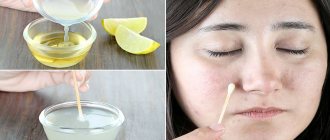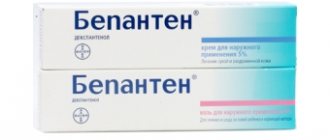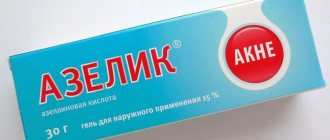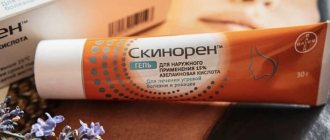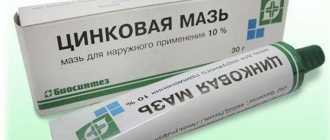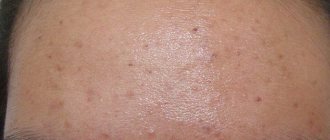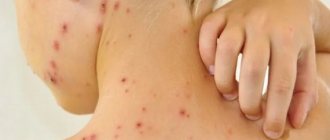Acne occurs in men and women against the background of various chronic diseases. To eliminate such an external defect, a large number of medicines have been manufactured, but they are not always able to eliminate the true cause of acne.
Treatment of acne skin should be carried out from the inside and using preparations for external treatment. For example, Dimexide for acne is a medicine for external use.
It quickly penetrates into the deep layers of the epidermis and has a local antimicrobial analgesic effect. Dimexide against skin rashes is prescribed in combination with antibiotics, enhancing the therapeutic effect of the latter.
Release form and composition
Acne medicine comes in several dosage forms:
- 25% gel for external use - has a slightly yellowish tint and a specific smell of garlic. Used to treat joint diseases and bruises. Packed in an aluminum tube;
- 99% concentrate for solution preparation - used for external use in volumes of 100 and 50 ml. Colorless oily liquid with a faint chemical odor similar to garlic. The solution is bottled in dark glass bottles with a tightly screwed cap.
To treat acne, pimples and acne, a concentrated solution of Dimexide is used. It is used in diluted form.
Composition of Dimexide gel for external use:
- Active ingredient: dimethyl sulfoxide;
- Methyl parahydroxybenzoate (nipagin)
- Propyl parahydroxybenzoate (nipazole)
- Carmellose sodium (sodium carboxymethylcellulose)
- Purified water - up to 100 g.
The concentrated solution of Dimexide consists of dimethyl sulfoxide 99 g.
Useful properties and action of Dimexide
Initially, Dimexide was used in surgical practice. After some time, cosmetologists paid attention to him.
Beneficial properties for the skin:
- Smoothes wrinkles;
- Tightens the skin and gives it radiance;
- Prevents the appearance of rashes;
- Fights acne and blackheads;
- Relieves irritation;
- Smoothes out acne marks;
- Accelerates the process of nutrients from other drugs used.
Dimexide has the following effect:
- Antibacterial;
- Anti-inflammatory;
- Healing;
- Is a conductor for other medicines;
- Enhances the positive effect on the dermis.
Scheme of action of the drug:
- Dimexide penetrates the skin and mucous membranes, disrupting the cell membrane and increasing their permeability to the effects of drugs;
- The medicinal substance paves the way for cosmetics and medications for acne, destroying the membrane of bacteria and pathogenic microorganisms;
- By loosening the skin, the externally acting drug penetrates into the lower layers of the epidermis and has a positive effect on subcutaneous pimples, boils, closed acne and comedones;
- Next, Dimexide penetrates into the joint cavity , binds to blood proteins in the tissues and is distributed throughout the body.
What is Dimexide used for?
The drug is prescribed for problems with the functioning of the musculoskeletal system. In addition, in case of subcutaneous damage to soft tissues, Dimexide actively relieves the inflammatory process. The ability of the drug to enhance the effect of other drugs is often used by doctors in antibacterial therapy. Direct indications for prescribing Dimexide are:
- bursitis;
- arthrosis;
- arthritis;
- radiculitis;
- gout;
- osteochondrosis;
- pain syndrome due to intervertebral hernia;
- scleroderma;
- skin ulcers;
- swelling accompanied by pain;
- synovitis
In addition to the above problems, Dimexide is also used in other areas, including cosmetology.
How to properly use Dimexide for acne?
A step-by-step guide will help you use Dimexide correctly and in the correct dosage.
It is important to note that the medicine in the form of a solution is not used in its pure form.
Before using dimexide for acne, you need to prepare your facial skin:
- Cleanse the skin of cosmetics with makeup remover foam;
- Wash with warm water without using soap;
- It is not recommended to squeeze pimples before treatment.
Sensitivity test
It is also worth conducting a sensitivity test to the components of Dimexide:
- Apply a couple of drops of a diluted Dimexide solution to the inside of the elbow at the bend;
- Wait 15-20 minutes, all the while observing the reaction;
- If symptoms such as burning, redness or rashes appear at the application site, then the concentration of the prepared product is too high and more water should be added.
Applications
Preparation of applications based on Dimexide:
- Applications are prepared from a concentrated solution for external use;
- For therapeutic measures, the product is mixed with chilled boiled or distilled water in a ratio of 1:4. For example, 1 tbsp. spoon of dimexide and 4 tbsp. spoons of distilled water;
- To prevent the formation of acne, Dimexide should be diluted in a ratio of 1:10.
Method of use:
- Soak a cotton pad in the prepared solution;
- Apply the disc to the area of greatest accumulation of acne;
- If acne covers the entire surface of the face, then it is advisable to use a cotton napkin, gauze or bandage. In this case, the application is applied to the entire face;
- Cover a moistened napkin or cotton pad with plastic wrap, and place a piece of thin, dense fabric, such as a waffle towel, on top of it;
- Duration of the procedure is 30 minutes;
- At the end of the procedure, wash your face with water at room temperature and lubricate the skin with a moisturizing or nourishing cream, since Dimexide has a drying property;
- Dimexide for acne is used only for oily skin types and for skin prone to rashes, as it dries out rashes on the skin;
- Applications are used 2-3 times a day with a freshly prepared solution;
- The course of treatment is 10-15 days.
It is important to know that Dimexide is quite toxic. When working with it, you must follow the safety measures prescribed in the instructions, as it can cause a chemical burn.
Doctors recommend
- After applying Dimexide to the skin, do not wrap it with bandages, films or other materials that interfere with air access. If it is necessary to apply a compress, be sure to use a soft cloth or cotton swab, do not use film and do not hold the compress for more than 15 minutes
- use the minimum effective dosage
- in case of allergic reactions, immediate cancellation is recommended
- allows the possibility of driving a vehicle during treatment.
Dimethyl sulfoxide can enhance not only the activity, but also the toxicity of drugs. Caution should be exercised when prescribing it and using it simultaneously with other medications.
Face masks based on Dimexide
These masks can be easily used at home.
Mask with Dimexide and tea tree oil
Suitable for eliminating all types of skin inflammation.
Compound:
- 2 drops of tea tree oil;
- Calendula decoction - 5 ml;
- 3 drops of concentrated Dimexide solution.
Preparation of the mask:
- Place 1 teaspoon dried calendula flowers in a small heatproof container;
- Add 0.2 liters of boiling water;
- Cook in a water bath for 20 minutes;
- Remove from heat, wrap the container in a towel, wait until it cools;
- Dilute Dimexide with five milliliters of calendula decoction;
- Add a couple drops of oil;
- Mix the ingredients well.
Apply the product directly to the pimple itself using a cotton swab. The mixture should be kept on the skin for 1.5-2 hours, after which the residue should be removed with a cotton swab dipped in warm water.
Treatment is carried out until the rash on the face disappears completely. For preventive purposes, this mask is not used. Frequent use of a mask of this composition is not recommended - 2 times a week is enough.
Mask with Dimexide and clay
Natural cleansing with this product removes dead skin cells without compromising the integrity of the skin tissue. Blood flow increases, swelling decreases.
Compound:
- 2 ml Dimexide;
- 10 gr. yellow clay;
- 5 ml watermelon oil.
Preparation and use of the mask:
- Combine Dimexide dissolved in 20 ml of water with clay and watermelon oil;
- Apply to steamed skin along the lymph flow lines;
- Leave on skin for 15 minutes;
- Rinse off the mask with warm water;
- Apply moisturizer.
The mask can be used no more than twice a week.
Sour cream mask with Dimexide
Used to get rid of rashes, while the skin is well moisturized and saturated with beneficial substances..
Compound:
- A tablespoon of blue clay;
- 2 tablespoons sour cream;
- Half a teaspoon of vitamin A and E;
- 6 drops of undiluted Dimexide.
Preparation and use of the mask:
- Dilute the clay with sour cream, add the remaining ingredients to the resulting mixture and mix thoroughly;
- Apply the mask to the surface of the epidermis in a thin layer, avoiding the eye and mouth area;
- Keep the product on your face for no more than 20 minutes;
- Wash off the mask with a decoction of chamomile or calendula;
- Repeat the procedure every 5-7 days.
To prevent acne, Dimexide can be used without additional components. It is enough to dilute it with water and wipe the skin daily, the concentration should not exceed 1:10.
Facial lotions based on Dimexide
Recipes for lotions based on dimethyl sulfoxide:
- Recipe No. 1 - 50 ml of Dimexide is mixed with 25 ml of Chlorophyllipt and one glass of water. A cotton pad moistened with the solution is applied to problem areas for 5 minutes. To prevent acne, the lotion is used daily, but not more than 2 weeks;
- Recipe No. 2 - 4 tablespoons of Dimexide are mixed with 4 ml of a solution of 1% salicylic acid. The lotion is used twice a day. The lotion dries out rashes and cleanses the epidermis of dead particles and dust. Used daily;
- Recipe No. 3 - lotion to maintain skin elasticity, its radiance and prevent skin rashes. One part of dimexide must be diluted with eight parts of chamomile decoction. The lotion is used daily before bedtime every other day;
- Recipe No. 4 - add a couple of drops of concentrated Dimexide solution to a moisturizer for problem skin. Treat problem areas of the skin by wiping, after removing makeup, before going to bed, every other day.
Face washes based on Dimexide
Using acne talkers is a very effective way. They are used to treat acne, acne among teenagers and older people.
Classic mash with Dimexide
A mash containing dimethyl sulfoxide is an effective remedy for acne.
Compound:
- Dimexide - fifty ml;
- Doxycycline - twenty capsules;
- Distilled water - 150 ml.
Preparation:
- Doxycycline capsules are opened and the powder is poured out;
- Pour 1 bottle (50 ml) of Dimexide solution;
- The mixture is stirred and poured into a larger bottle with a tightly screwed cap;
- Leave for a day, shaking occasionally;
- After 24 hours, add water and shake the resulting mixture.
Application:
- The mash is applied to damaged facial skin 2 times a day: morning and evening;
- After the mixture has dried, the skin is lubricated with a moisturizing gel or face cream.
Most often, cleansing of the skin occurs in the third week of treatment. The course lasts up to 21 days with daily use.
Face wash with Dimexide and activated carbon
Compound:
Preparation:
- The tablets are ground into powder, filled with purified water and mixed;
- After adding dimexide, the mixture is stirred again.
The mixture can be used as a facial scrub, if you reduce the amount of water, this application can be done once a week.
Application and application:
- The solution is applied with a cotton pad;
- Residues are washed off with warm water after 15 minutes;
- Nourishing cream is applied;
- Use no more than 2 times a week.
Chatterbox with Dimexide and mineral water
Compound:
- Dimexide solution;
- Any mineral water.
Preparation and use:
- Mix Dimexide with mineral water in a ratio of 1:6 or 1:8;
- Soak a cotton pad in the resulting solution;
- Wipe problem areas of the skin 3-4 times a day;
- The course of treatment should not exceed 2 weeks;
- Between courses you should take a two-week break.
Pimples that appear on the skin due to fungi of the genus Candida or Demodex mites can be cured with a Dimexide-based talker, adding drugs such as Solcoseryl, Clotrimazole or Syntomycin to it.
Frequently asked questions about the use of Dimexide for acne
Can dimexide be used for acne during pregnancy?
Doctors and manufacturers of drugs based on dimethyl sulfoxide do not recommend use during pregnancy and breastfeeding. Clinical trials have not been conducted in this group and therefore the consequences of use are unpredictable.
Can dimexide be used to treat acne with glaucoma?
The instructions for use describe all contraindications; it cannot be used if you have glaucoma. Also in the list of contraindications are diseases such as cataracts, pronounced atherosclerosis, cardiovascular failure, kidney and liver diseases, after any type of stroke and angina.
I use dimexide after a stroke, but it is on the list of contraindications, is it dangerous?
It is dangerous, it was prescribed in the contraindications section: after a stroke, taking the drug is contraindicated. You assume all risks and complications resulting from the use of drugs with dimethyl sulfoxide after a stroke.
Is it possible to use dimexide for childhood acne?
Contraindications for children are specified in the instructions for use of the drug: use is contraindicated for children under 12 years of age. Some medications and ointments containing dimethyl sulfoxide should not be taken by children under 16 years of age. Read the instructions and the contraindications section very carefully before using it on children.
Features of application
Features of using Dimexide:
- Consultation with a dermatologist is necessary; do not self-medicate;
- Dimexide has an adverse effect on thin and sensitive skin in the form of allergies or burns;
- The product is purchased only from pharmaceutical organizations and pharmacies;
- Before using the concentrated solution, it is necessary to conduct a sensitivity test.
- The product is used to smooth out wrinkles in a diluted form.
Pharmacological properties
Penetrating through the skin and mucous membranes, Dimexide has the following therapeutic effects:
- stops the inflammatory process in affected tissues;
- relieves swelling and redness;
- produces an antiseptic effect, has a detrimental effect on pathogenic microflora of viral, bacterial or fungal origin;
- eliminates pain and increased sensitivity by blocking nerve endings in the affected area;
- improves metabolism, accelerates healing and restoration of damaged tissues.
Dimexide also acts as a conductor, therefore it improves the permeability of other medications, thereby enhancing their therapeutic effect.
Precautionary measures
The use of the product is associated with the risk of burns and adverse effects, so it is important to follow a number of rules when handling the drug.
The main ones:
- The drug should be used carefully , following the instructions. To better achieve a therapeutic effect, the dose cannot be increased;
- Apply compresses, masks and lotions only to previously cleansed facial skin , without using other cosmetics;
- Avoid contact with mucous membranes and eyes ; if dimexide gets on them, rinse with plenty of water;
- Adhere to the algorithm for preparing the working solution and application scheme;
- Dimexide is soluble only in water , so mixing it with oils and alcohol solutions is not allowed; this can lead to serious chemical burns.
If the recipe for preparing masks or lotions includes essential oils, then Dimexide is first diluted in distilled water in a ratio of 1:10, and then the oil is added.
Is it possible to overdose?
An overdose of Dimexide is possible if the acne remedy is used incorrectly:
- Burns are a consequence of non-compliance with the recommended concentration;
- Dimexide poisoning occurs when the drug is used for other purposes, for example, orally. The result is a burn of the oral mucosa and esophagus;
- Allergic reactions accompanied by bronchopulmonary edema occur when masks and compresses are used incorrectly.
Drug interactions
Interaction of Dimexide with other drugs:
- Dimexide accelerates the absorption of insulin;
- It has enhancing effects when combined with ethanol;
- Increases sensitivity to aminoglycoside and beta-lactam antibiotics;
- Increases the effect of chloramphenicol, rifampicin, griseofulvin.
- Used in combination with heparin and NSAIDs, increasing their effectiveness
- Develops the body's resistance to general anesthesia drugs.
Side effects
Possible burning, redness, chemical burns, rashes and itching.
With significant doses and indoor use, dizziness and nausea may occur when inhaling the odor of dimethyl sulfoxide. Other side effects caused by individual intolerance to the components of the drug.
Full review and detailed information about side effects
Side effects >>>
Price
Dimexide is an inexpensive medicinal substance. Approximate prices can be found in the table below.
| Dosage form | average price |
| Concentrated solution 100 ml | 60 - 70 rubles |
| Concentrated solution 50 ml | 35 - 40 rubles |
| Gel for external use 25% 30 g | 150 - 170 rubles |
Possible analogues
Dimexide has no structural analogues.
There are drugs with similar effects:
- Baziron AS is a gel for external use. The active ingredient is benzoyl peroxide aqueous. Baziron AS exhibits an antimicrobial effect against pathogenic bacteria, prevents the formation of excessive amounts of sebum, and improves redox reactions in tissues. Used to treat acne. The approximate cost of the drug is 800 rubles ;
- Differin cream is a retinoid drug for the treatment of acne. The active ingredient is adapalene. It has anti-inflammatory and comedolytic effects. The drug interacts with the receptors of epidermal cells, which prevents the formation of microcomedones. Approximate cost 900 rubles ;
- Adaklin cream – the main substance is adapalene. Indications for treatment: acne. The principle of action is similar to Differin. In addition, Adaklin cream inhibits the migration of leukocytes to the site of inflammation. The approximate cost of the product is 550 rubles .
Baziron AS Differin Adaklin
Symptoms and causes of acne
The causes of the disease remain unclear. In the mechanism of development and appearance of acne, the main role is played by seborrhea, which reduces the bactericidal effect of sebum and leads to the activation of coccal flora. An important role in the mechanism of acne is played by the bacterium Propionibacterium acnes and its metabolic products.
Common acne (juvenile pimples, acne) develops in boys and girls during puberty and gradually disappears by the age of 25-30. The appearance and worsening of acne is also influenced by menstruation, stress, heat, high humidity and genetic factors. It is known that cosmetics containing lanolin and paraffin are also the cause of acne. Acne can also be a side effect of certain medications.
Hyperkeratinization and plaque formation of keratin and sebum leads to enlargement of the sebaceous glands, especially during skin maturation during puberty. An increase in sebum production occurs during adrenarche, when the production of dehydroepiandrosterone increases.
The accumulation of sebum can lead to infection. The immune system destroys the bacteria, and the pus is “packed” into clusters under the epidermis. Patients try to get rid of pustules by removing them themselves and in non-sterile conditions. Such damage to the underlying layers disrupts the delicate structure of the dermis and creates a weakened zone that is attacked by bacteria. As a result, the immune system causes acne to spread.

